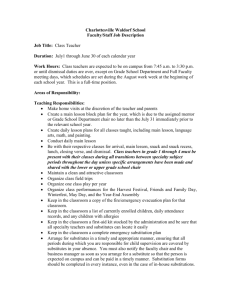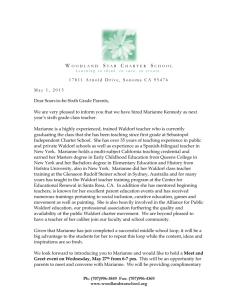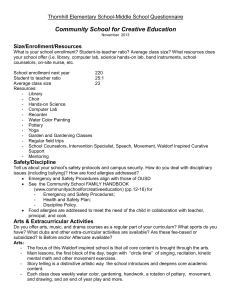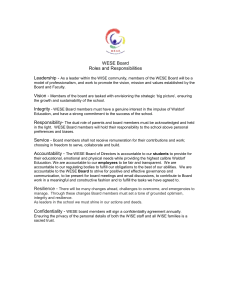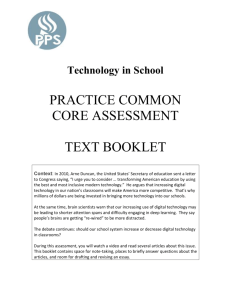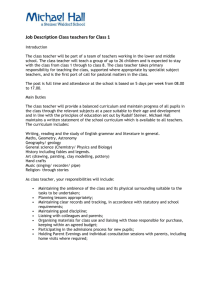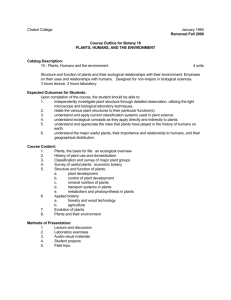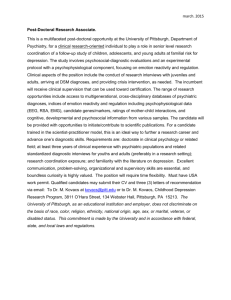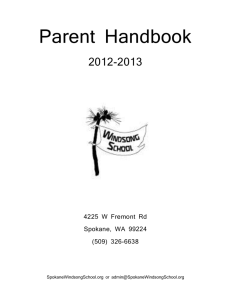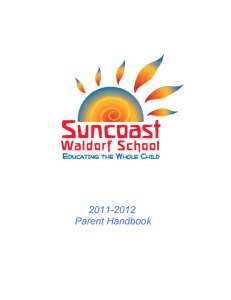Botany Curriculum Guide
advertisement
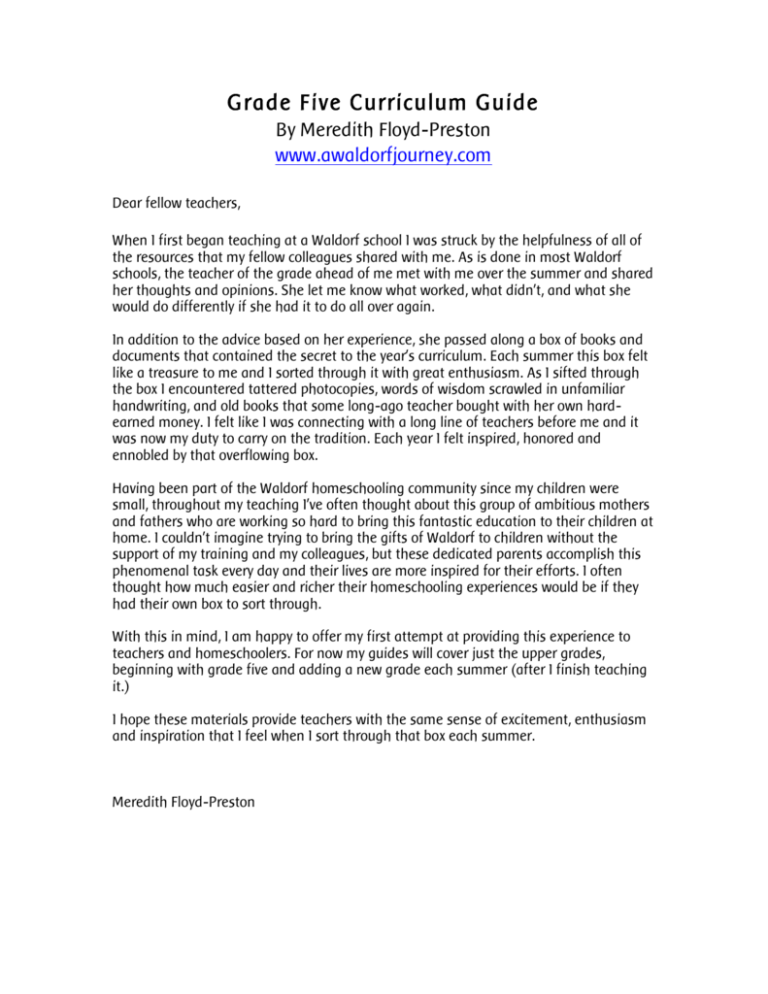
Grade Five Curriculum Guide By Meredith Floyd-Preston www.awaldorfjourney.com Dear fellow teachers, When I first began teaching at a Waldorf school I was struck by the helpfulness of all of the resources that my fellow colleagues shared with me. As is done in most Waldorf schools, the teacher of the grade ahead of me met with me over the summer and shared her thoughts and opinions. She let me know what worked, what didn’t, and what she would do differently if she had it to do all over again. In addition to the advice based on her experience, she passed along a box of books and documents that contained the secret to the year’s curriculum. Each summer this box felt like a treasure to me and I sorted through it with great enthusiasm. As I sifted through the box I encountered tattered photocopies, words of wisdom scrawled in unfamiliar handwriting, and old books that some long-ago teacher bought with her own hardearned money. I felt like I was connecting with a long line of teachers before me and it was now my duty to carry on the tradition. Each year I felt inspired, honored and ennobled by that overflowing box. Having been part of the Waldorf homeschooling community since my children were small, throughout my teaching I’ve often thought about this group of ambitious mothers and fathers who are working so hard to bring this fantastic education to their children at home. I couldn’t imagine trying to bring the gifts of Waldorf to children without the support of my training and my colleagues, but these dedicated parents accomplish this phenomenal task every day and their lives are more inspired for their efforts. I often thought how much easier and richer their homeschooling experiences would be if they had their own box to sort through. With this in mind, I am happy to offer my first attempt at providing this experience to teachers and homeschoolers. For now my guides will cover just the upper grades, beginning with grade five and adding a new grade each summer (after I finish teaching it.) I hope these materials provide teachers with the same sense of excitement, enthusiasm and inspiration that I feel when I sort through that box each summer. Meredith Floyd-Preston First . . . a word about this guide. This guide is not, by any means, a complete curriculum. There are plenty of resources for complete Waldorf curricula out there. Most Waldorf teachers do not use these curricula, preferring instead to create the curriculum themselves, from scratch, individually tailored to their own and their students’ interests. There are, however, curriculum standards and resources that most Waldorf teachers use. These resources (in addition to my own experiences) are what I have used to create this guide. Some of what is included here, though, cannot be found in any resource. What this document represents is a weaving together of traditional Waldorf resources, mainstream education resources, reader recommendations and my own thoughts and ideas based on my experience. The guide is divided into blocks. The main lesson blocks for Grade Five include: Botany Ancient Civilizations – India and Persia North American Geography Math – Place Value and Introduction to Decimals Ancient Civilizations – Mesopotamia and Egypt Math – The Metric System Greek Mythology Greek History Usually the blocks are broken down in this way, though there are certainly other ways to approach it. Most often North American Geography and Botany are split into two blocks, one at the beginning and one at the end of the year. For each block you will find lots of information, including: Ø Ø Ø Ø Ø Ø Ø Primary content resources A day to day content outline Sample main lesson book pages Daily dictations Recommendations for readers, and study questions to go with them Homework samples Suggestions for special projects Though this is a lot of very useful information, I am not providing you with the content itself. For example, I may recommend that the India block consist of three days of the story of Buddha, but I do not provide you with a story to tell, read or have your students read. I give recommended resources, but it is up to you to find the version of the content that speaks most to you and your students. Though some of these recommended resources are “Waldorf books” and would need to be purchased, many of them can be found at your local library. Throughout my teaching I have always made liberal use of the library. My experience is that the “Waldorf books” do not usually include anything that can’t be found at the library. They have usually just broken the content down into pieces that are manageable for a main lesson. In my day-to-day content outline I give a basic explanation of the new content that is to be presented that day. I don’t address the recall portion of main lesson. In my experience, this part of the lesson varies quite a bit depending on what aspect of the lesson spoke most strongly to the students. In my Main Lesson 101 guide I give ideas for different ways of doing the recall and by looking at my sample main lesson book pages you can get an idea of what I did with my class. I’ve also included a Dictation Guide that explains my approach to dictation – one of my favorite aspects of our fifth grade year. I hope the information provided in this guide helps you to become inspired by the wonder of the Waldorf curriculum. Sincerely, Meredith Floyd-Preston p.s. I have written this guide to be useful for school-teachers and homeschoolers alike. Because most of my experience is in a classroom setting, I sometimes refer to the “class” or “students” (plural) but usually my recommended activities and experiences can be applied to both homeschool and classroom settings. Sometimes this is not the case and I have given alternative advice for homeschoolers. As you read, please adapt my recommendations to what would work best in your particular situation. The Waldorf Curriculum brings a very unique slant to the scientific subject of Botany. In fifth grade the subject of Botany picks up the study of the physical sciences where the Human and Animal block in fourth grade left off. Throughout the grades the students will study the natural kingdoms progressively further away from the human being. The beauty, balance and perfection in the physical form of the plants meet the fifth grader perfectly. The Waldorf approach to Botany attempts to take this scientific subject matter and imbue it with imagination. The best way to do this is to personify the plant. From the beginning of the block the plant is portrayed as “a child of the sun and the earth.” The earth is the mother and the sun is the father. Like all children, the plant takes some qualities from its mother and others from its father. Together you can look at the different parts of the plant that are more sun-like and parts that are more earth-like. Then, when it comes time to talk about plant reproduction, by talking about the “little bit of sun” and the “little bit of earth” coming together, you can keep the topic comfortably away from the subject of human reproduction. Keeping the subject in the imaginative realm, we stay away from dry topics (like photosynthesis) that are too far away from the students’ experience. The block follows a basic progression beginning with this depiction of the plant as a child. The study then follows the evolution through the plant families relating each family to a particular-aged child. The mushroom is the baby, the conifer a teenager, right up to the adult full, flowering plant. The first block ends with a basic distinction between a monocotyledon and dicotyledon in the contrast of the tulip and the rose. Primary Resources The Living World of Plants by Gerbert Grohmann – If you can buy only one book for this block, this is the one to get. On my Amazon search it came up unavailable, but the Rudolf Steiner College Bookstore (http://www.steinercollege.edu/store/) carries it. Grohmann took his adult series The Plant and wrote a simplified version for 10-11 year olds. The content is broken down into easily digested and delivered main lesson sized chunks. Botany by Charles Kovacs – In this book Kovacs took the material presented by Grohmann and infused it with a little more imagination. I used both Grohmann’s and Kovacs’ book in teaching this block, and Kovacs’ book is great, but I still maintain that Grohmann’s is more useful. I love Kovacs’ books and I have used all of his others. If you have Kovacs’ book already but don’t have Grohmann’s Kovacs will serve you quite well. Don’t worry about ordering another book. The Plant Vol. 1 and 2 by Gerbert Grohmann – These are adult books. My library had them and I read them over the summer. They gave a richer picture to accompany The Living World of Plants but they were much more information than I needed. Secondary Resources John Muir: My Life With Nature by John Muir, Joseph Cornell, Elizabeth Ann Kelley and Christopher Canyon – In addition to the more factual content of Botany, I told the students biographies of famous naturalists. John Muir is a fascinating individual and is not to be missed. This children’s book is decent enough – a quick read and easy to translate into storytelling – but I would have like to have read a more complete biography over the summer. Adventures in Treesitting – Julia Butterfly Hill – The story of Julia Butterfly Hill, the woman who, for three years, lived in a tree she named Luna, is another fantastic biography to tell. Adventures in Treesitting is actually a video I found on YouTube. I’m sure there are proper copies of it to be had, but I couldn’t find it anywhere, so I watched the YouTube version. Julia herself tells much of the story in a very lively and engaging way. Girls Who Looked Under Rocks: The Lives of Six Pioneering Naturalists by Jeannine Atkins and Paula Conner – This collection of biographical stories was a class reader. See full version for Ø Ø Ø Ø Ø Ø Ø Day-to-Day New Content Outline Dictation Guide and Daily Dictations Reader and Study Questions Sample Homework Ideas for Special Projects More main lesson book pages Main lesson book feedback rubric
